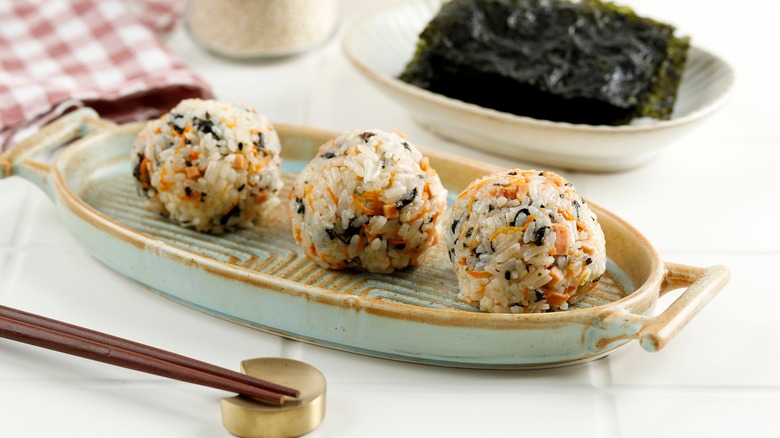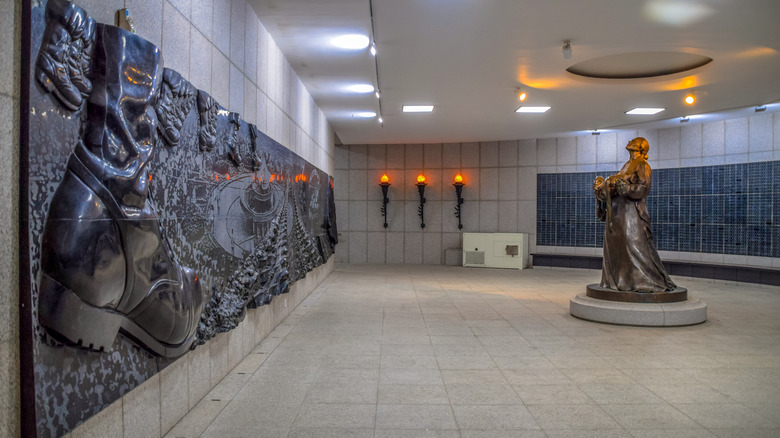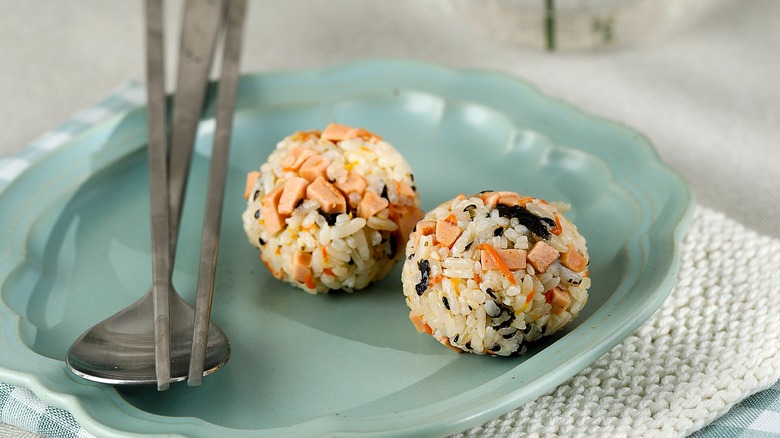What Jumeokbap Symbolizes For Korea
In China and Taiwan, they're called fan tuan, per Vice, while in Japan, they are known as onigiri or omusubi, according to Just One Cookbook. Rice balls may have been nourishing Asians for centuries, but jumeokbap is more than a savory appetizer for Koreans. My Korean Kitchen says jumeokbap, which means "fist rice," has been around for centuries. The Korean language site N Culture says the balls are usually made with short-grain Japonica rice because it is stickier, more pliable, and easy to shape.
Rice balls started out in Japan as a dish the aristocracy gave to servants, but Shun Gate says that by the Kamakura period, the portable meal became something everyone would enjoy. Samurai were said to pack rice balls as field rations, and during the Edo period (1603-1868), they began wrapping rice balls with seaweed. N Culture writes that the rice balls must have crossed over into Korea at some point because they were packed and carried by both Korean and Japanese soldiers in wartime. Because they were easy to carry, they could be packed for journeys when people needed to travel long distances. Essentially, the only difference between the Japanese onigiri and the Korean jumeokbap is its shape, where the former comes in the shape of a pyramid, and the latter, a sphere.
Jumeokbap as democratic symbol
Korean jumeokbap became known as a symbol for something else entirely in 1980 when the southwestern city of Gwangju became the center of the country's pro-democracy movement. On May 18, six hundred students and civilians had gathered at the Chonnam National University to demand academic freedom when they were assaulted by government forces (via Britannica). The city was blockaded, so it became inaccessible to both aid workers and journalists, so when the protesters ran out of food, they were fed jumeokbap made by city residents, according to Atlas Obscura. Protestors referred to the women who were on the front lines making the rice balls as "eomonim (mother), halmoni (granny), imo (auntie), or nuna (big sis)."
The rebellion ultimately ended in tragedy. Britannica says the government killed nearly 200 protestors when authorities stormed the city to reclaim it. The city residents dispute this number, saying the real number of those slain is closer to 2,000.
It would be years before democracy would eventually come to Korea. In 1993, the country got its first democratically elected leader Kim Young-Sam; and in 1998, a man who had been sentenced to death for the part he played in the uprising, Kim Dae-Jung, became its second democratically elected president. In 2019, Atlas Obscura says jumeokbap became an official symbol of the city of Gwangju.
Jumeokbap has evolved to become a convenience
Atlas Obscura says some women in Gwangju insist that jumeokbap be made the traditional way because the simplicity of the dish reflects its working-class roots. But to those whose interest in jumeokbap is strictly culinary, fist rice has also become a trendy fast food.
My Korean Kitchen offers up two different jumeokbap flavors: one made with Korean beef (bulgogi) flavored with soy sauce, mirin, dark brown sugar, and sesame oil and the other made with anchovies, flavored with soy sauce, rice wine, honey and sesame oil sauce. Its rice base remains the same typically using Japonica rice or sushi rice since both are sticky enough to hold their shape. The rice balls can also be coated with seasoned seaweed flakes for added flavor. If you want to experiment with other jumeokbap fillings, Drive Me Hungry also recommends fish cakes; mushrooms and spinach, or and cream cheese.
So whether you prefer it simply or loaded with umami flavor, don't forsake the dish's rich and complicated history.


